- You are here:
- Home »
- Cauchi
Tag Archives for " Cauchi "
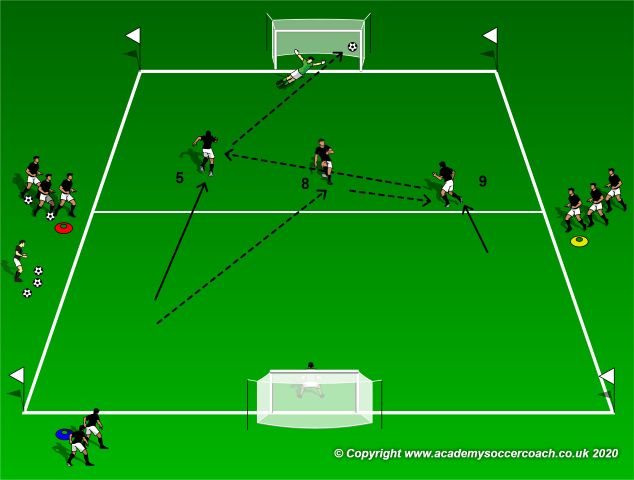
Conditioning Session Combined With Finishing
By Philip Cauchi
Theme: Intermittent training.
Development of the soccer domains:
Technical: Receiving, passing and shooting at goal.
Tactical: Mobility, length and depth in attack.
Mental: Move quickly to provide a passing option after playing the ball.
Physical: Keep performing the quality of football actions for a prolonged period of time by delaying the onset of fatigue.
Organization: Area measuring 40 yards in length x 20 yards in width. Three groups of players at positions 5, 8 and 9 and two goalkeepers in goal.
Training load: 6 blocks of 3 minutes with a 1 minute of rest in between blocks (work to rest ratio 3:1).
Periodization: The exercise should be carried out on the endurance day which is at least 72 hours prior to a match and not less than 72 hours following the previous one.
Targeted energy system: Aerobic lactic (perform a high number of football actions with minimal rest in between repetitions).
Training considerations: Consider the total load of the session and adjust the training load accordingly. This practice should be performed after tactical training as the players are required to be physically and mentally fresh for tactical practices. Thus, making sure that they will be focused on the tactical details.
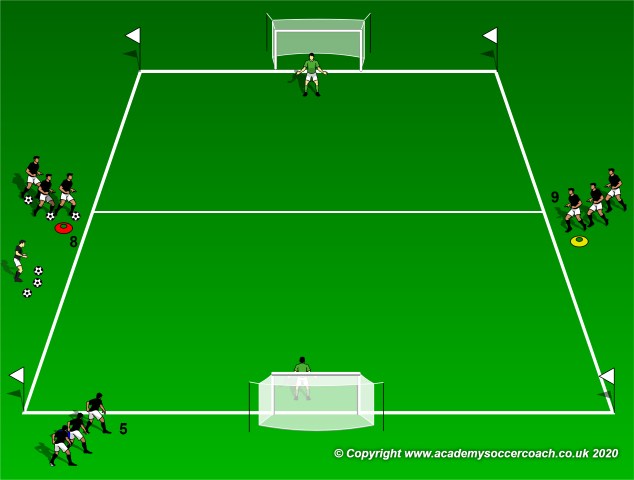
Player at position 8 starts with the ball. We can assimilate the positioning of the players to the positions they play in our system of play.
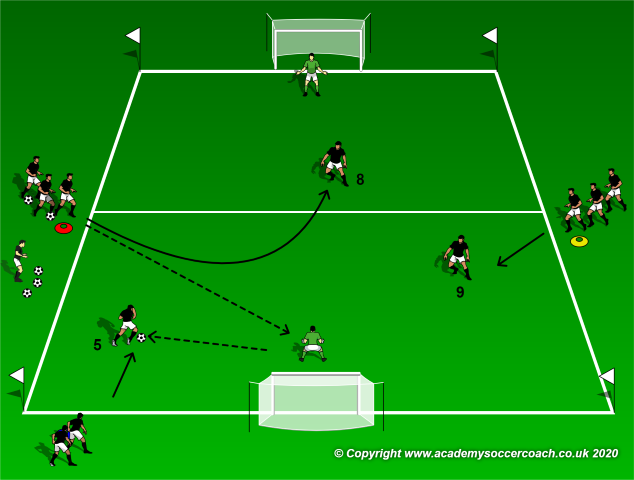
Player 8 passes the ball to the goalkeeper. Now, the three players must finish in the opposite goal in four or five passes maximum. The number of passes start being counted when the goalkeeper passes the first ball. The sequence of passes is for the players to decide. However, we give them these constraints. They must try to play with a maximum of two touch, they must move after passing the ball, they cannot be on the same vertical and horizontal lines and at the moment of shooting, they must all have crossed the midline.

Encourage off-the-ball movement and passing speed. Afterwards, the players move to a new position anticlockwise. When the round is over, the goalkeepers switch goalposts so that now the one who was involved in the build-up will be stopping shots and vice versa.
Progression:
Have four groups of players. When the ball is played back to the goalkeeper, the four players should form a diamond shape. The goalkeeper then decides to whom to play the ball. As constraints include that all four players should touch the ball at least once, they should move after passing, they cannot be in the same horizontal and vertical lines, and they must conclude in the opposite goal in under 15 seconds. As in the previous exercise, all the attacking players must be in the opposite half of the field when the shot is taken. When the round is over, the goalkeepers switch goalposts so that now the one who was involved in the build-up will be stopping shots and vice versa.
As a further progression the coach calls out to whom the goalkeeper should pass the first ball. As an example the coach may shout “number 9” and the goalkeeper plays a direct ball to the number 9.
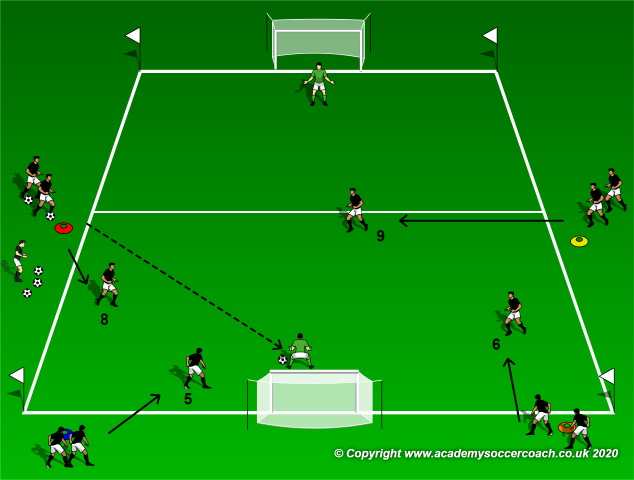
In this progression we have four groups. More options for the build-up and ball circulation exists.
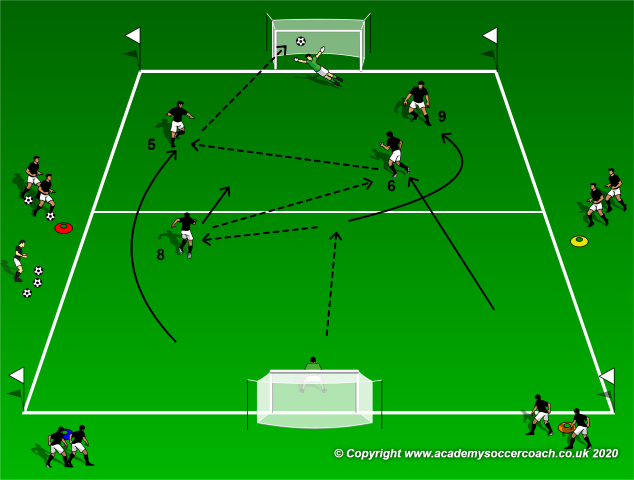
Encourage the players to perform off-the-ball movements after passing the ball such as overlaps and underlaps.
By Philip Cauchi
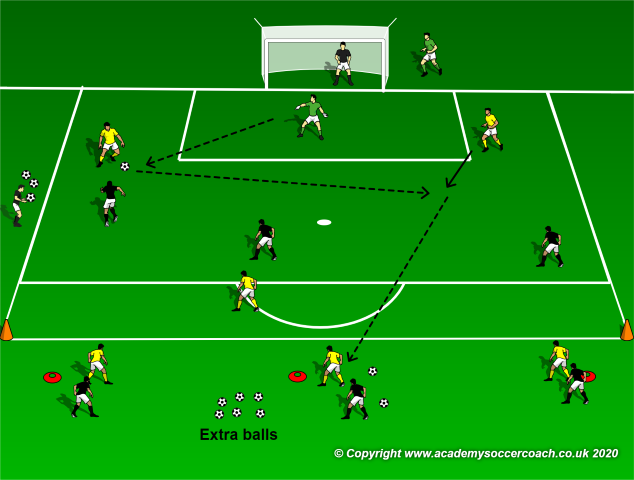
High Intensity Training 3v3+GK
By Philip Cauchi
Theme: Aerobic high intensity intermittent.
Development of the soccer domains:
Technical: Receiving, passing, dribbling, shooting, tackling, and blocking shots and goalkeeping.
Tactical: Defend aggressively inside the penalty area. Movement on and off-the-ball to create space to conclude at goal from inside the penalty area. Immediate transitions.
Mental: Anticipate quickly the movement of the opponent to be first on the ball. React quickly to moments of transitions.
Physical: Maintain a high intensity work rate while delaying the accumulation of fatigue.
Organisation: Area measuring 25 yards in length x 20 yards in width. A goalkeeper in goal with the goalkeeper coach behind him (if present) and another goalkeeper outside the goal ready to take her turn. Three defenders start inside the area. Groups of three players each outside the area as shown in the diagram hereunder. A number of balls should be available so if the ball goes out of playing bounds a new ball is put into play.
Training load: 2 blocks x 4 repetitions x 2 minutes each repetition interspersed with a recovery of one minute between repetitions and three minutes between blocks.
Total duration: approximately 30 minutes.
Periodization: The exercise should be carried out at least 72 hours prior to the next match (MD-3) and allow at least another 72 hours following the previous match.
Targeted energy system: Anaerobic lactic (delay the accumulation of lactate by having the body recover at a high rate between bouts of intense physical activity).
Training considerations: Ensure that the players are properly warmed up prior to commencing this activity. Group the players according to their position. For example the defence unit, the midfield unit and the forward unit.
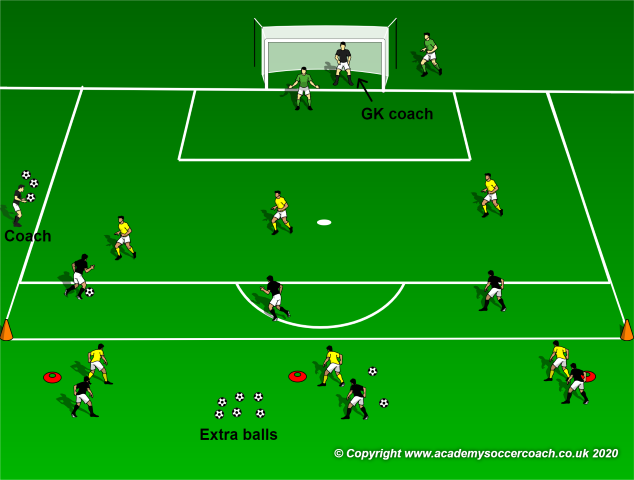
Three attackers start against three defenders plus a goalkeeper in goal. To allow the defenders time to recover, especially in moments of transition, the attackers may only score from inside the penalty area.
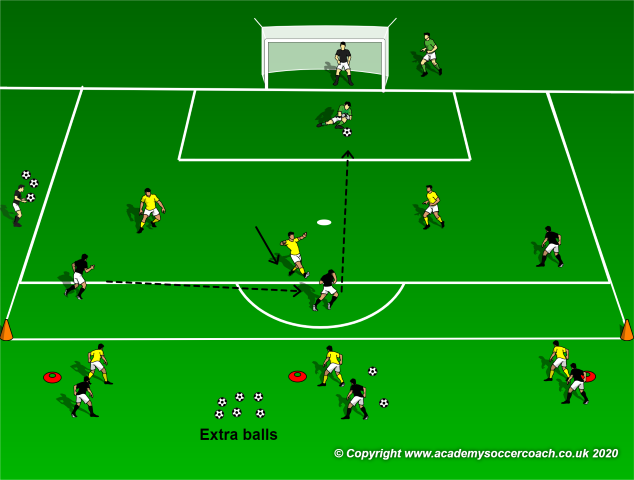
The actions are highly intensive and not only from a physical perspective but also from the mental.

If the goalkeeper makes the safe he can play it directly to the target players waiting outside the penalty area (yellows who are next in line to attack) or pass it to the defenders whose aim is to pass it to their teammates waiting to attack.
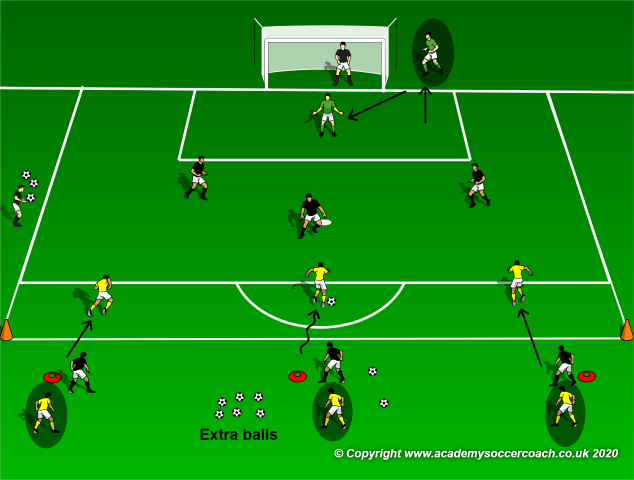
On transition, the previously attacking team (blacks) now defend while the previously defending team rests (circled). The goalkeepers switch after every attack or after a number of pre-established attacks.
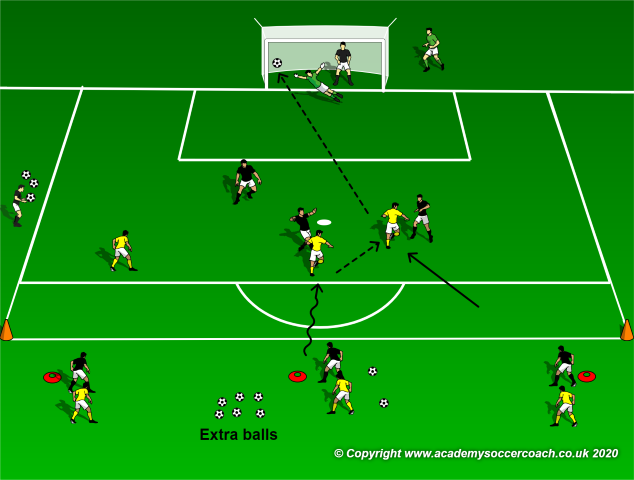
The attacking team (yellows) score. They have to transition immediately to defend. If their shot went wide, they would still transition to defend.
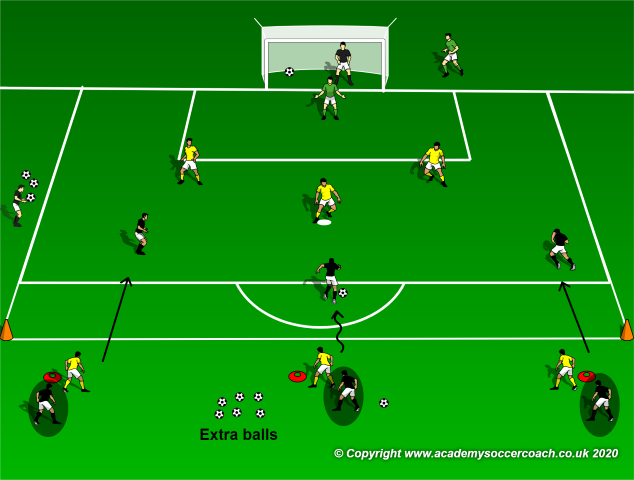
Now the previously attacking trio defend and the previously defending team rests (circled). A new team take their turn to attack.
Progression: To make it more challenging for a new attacking team, they must score after making three sequential passes following a transition (when the previously attacking team starts defending and a new team take their turn to attack). This gives the newly defending team more time to settle. However, afterwards the attacking team may score at any moment. This especially applies if the defending team wins the ball and the attacking team puts intensive pressure to regain possession. In this situation the attackers may score immediately if possession is regained. Thus the match realism of the practice is retained.
By Philip Cauchi
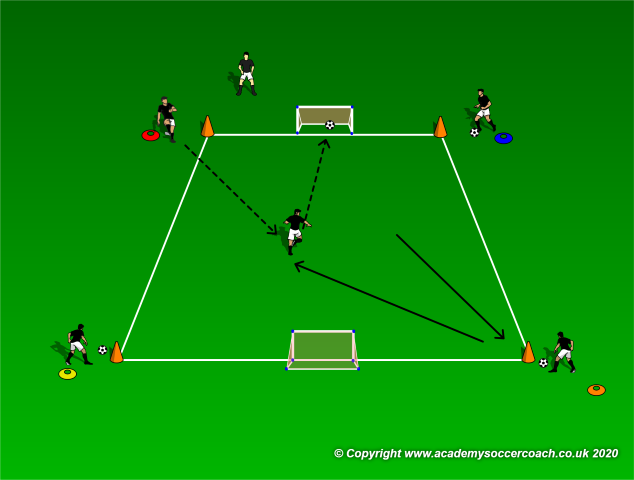
Four Corners Reactive Agility
By Philip Cauchi
Title: Four corners reactive agility.
Theme: Reactive agility.
Development of the soccer domains:
Technical: Receiving and passing the ball with accuracy.
Tactical: n/a.
Mental: React quickly to verbal and visual stimuli.
Physical: Perform quick changes of direction at speed while maintaining balance.
Organisation: Area measuring 5 yards x 5 yards. A player with a ball is positioned at each corner of the grid. Two mini goals are positioned facing each other. Corners are marked differently from each other using markers. The player to perform the agility exercise should start from the middle of the area.
Training load:
Sets: 1.
Repetitions: 4 to 6.
Duration each repetition: 8 to 10 seconds.
Recovery between repetitions: Between 80 and 100 seconds (approximate work to rest ratio of 1:10).
Periodization: The exercise should be carried out immediately after the warm-up when the players are fresh. The session should take place approximately 24 hours before a match (MD-1) as an activation.
Targeted energy system: Anaerobic alactic (produce energy rapidly with minimal lactic acid build-up, thus using the ATP-PCr system).
Training considerations: Perform only four quick changes of direction so to keep the duration of each repetition low. The intensity should however be high throughout the exercise, sets and repetitions. Keep with the recommended work to rest ratio and the total number of repetitions as we don’t want any accumulation of fatigue a day before the match.
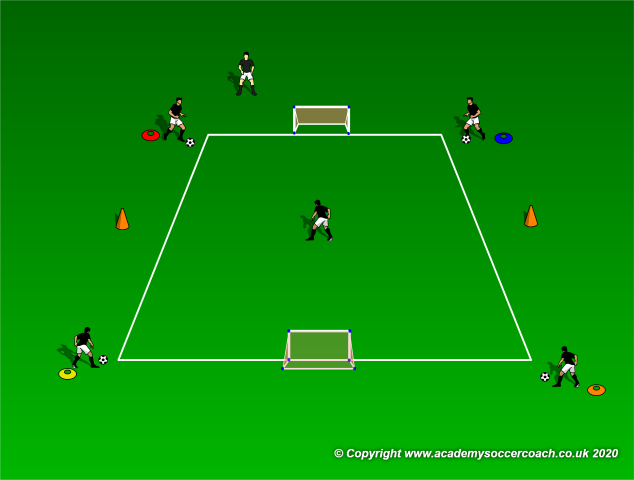
The coach at the top of the diagram shouts or shows a color using a marker.
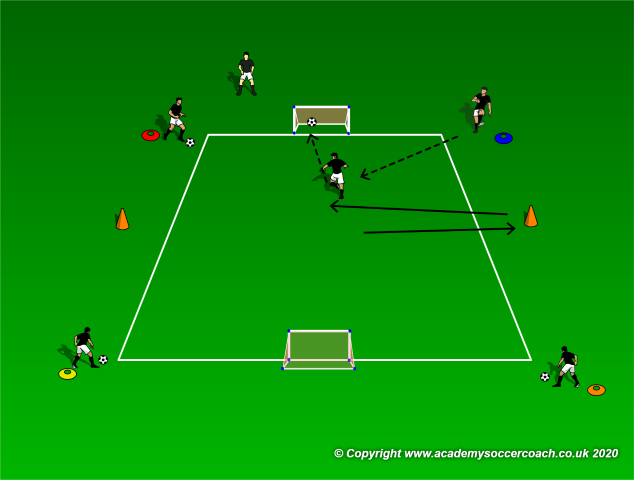
The coach called “blue”, therefore the player in the middle ran to touch the cone that is on the same side as the player on the blue marker. The latter passes the ball to the player in the middle who receives and concludes on the mini goal.
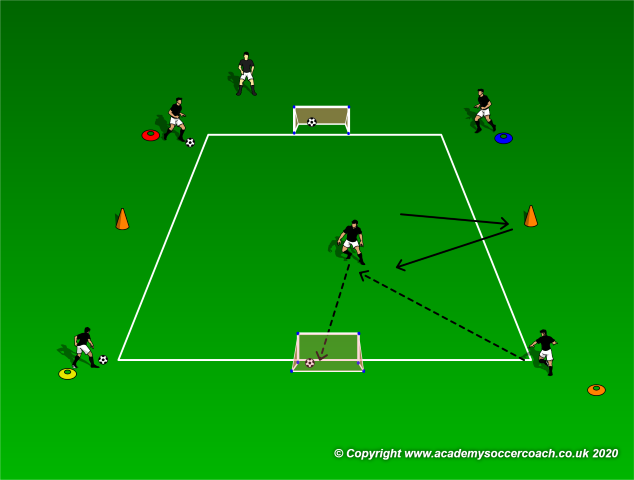
Immediately the coach calls “orange”, the player in the middle again sprints to touch the cone positioned on the same side of the player at the orange corner. The latter passes to the player in the middle who finishes on the mini goal.
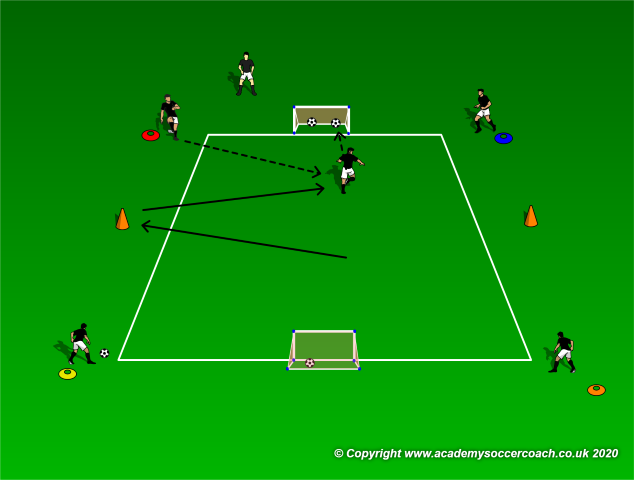
Immediately the coach calls “red” and the player in the middle sprints to touch the cone positioned on the same side as the player at the red corner prior to receiving the ball and finishing on the mini goal.
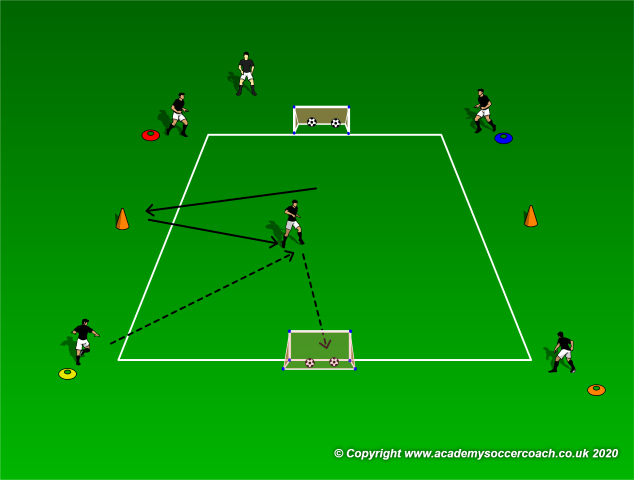
The same as the above sequences is done for the last ball received from the player situated at the yellow corner.
Progressions:
Progression 1 – The player in the middle must conclude at the mini goal with one touch.
Progression 2 – The player in the middle receives tossed balls to head in the mini goals.
6
Progression 3 – The player in the middle must touch the cone opposite the colour called, then turn to receive the ball from the player standing at the called corner (previous image).
Note about the exercise:
Personally I prefer working using visual stimuli as these are the stimuli that the players will have to process the most during the course of a game.
By Philip Cauchi
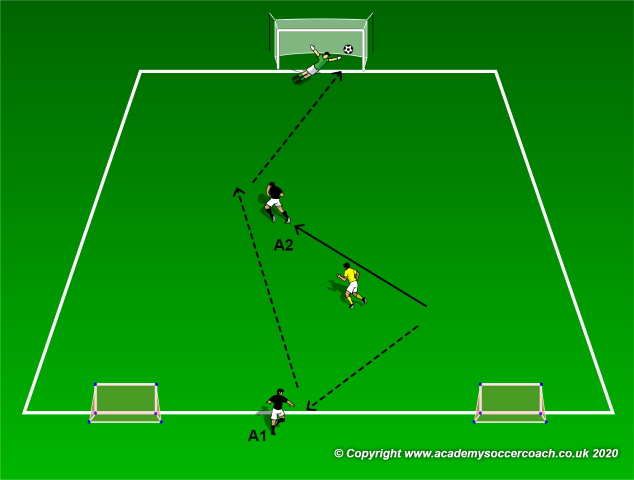
1v1 Conditioning Drills
By Philip Cauchi
Title: Strength in the duel – get unmarked in a 1v1.
Theme: Strength in the duel.
Development of the soccer domains:
Technical: Quality of technical actions performed under heavy opposition pressure such as shielding the ball, passing the ball with accuracy, oriented first touch and shooting.
Tactical: Perform off-the-ball movements such as the counter-movement to get unmarked.
Mental: Play under opposition pressure whilst thinking of various moves to get into an advantageous position to get past the direct opponent.
Physical: Perform quick and rapid explosive movements while holding off the pressure put by the opponent to maintain the body in a state of equilibrium.
Organisation: A regular goal plus a goalkeeper guarding it and two mini goals on the opposite end line. The practice area measures 15 yards by 10 yards. We have a group of attackers and another of defenders. Each group should not have more than four players.
Training load:
Sets: 2.
Repetitions: 6.
Duration each repetition: 12 to 20 seconds.
Recovery between repetitions: 80 seconds (approximate work to rest ratio of 1:4).
Recovery between sets: 3 minutes (light technical activity may be performed during this period thus accelerating the recovery process).
N.B. The training load should be adjusted according to the physical level and maturity of the players. Players should practice in positions and situations they typically experience during a match.
Periodization: The exercise should be carried out immediately after the warm-up when the players are fresh. The session should take place four days before a match (MD-4) and at least seventy two hours past the previous one (MD+3).
Targeted energy system: Anaerobic alactic (produce energy rapidly with minimal lactic acid build-up).
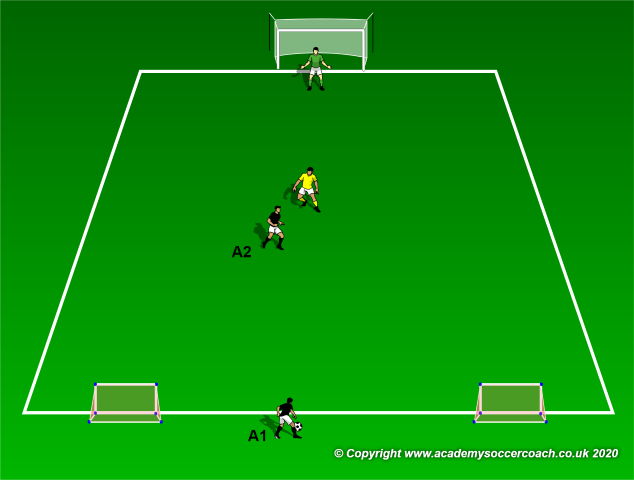
Attacker A1 starts with the ball at his feet. Attacker A2 must perform off-the-ball movements in order to get free from the defender’s marking.
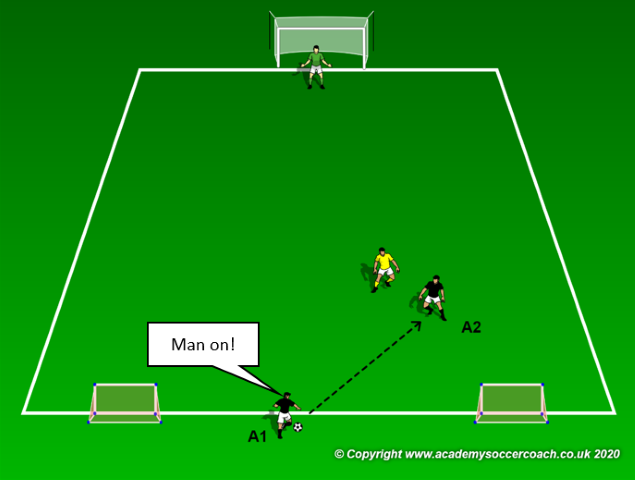
Attacker A1 passes the ball to attacker A2 once the latter gets enough space to receive the ball. Attacker A1 should also coach attacker A2 by calling “man-on” if the defender is putting pressure on him, or “turn” if space is allowed.

The ball may be played back to A1 while A2 attacks the space created behind the defender. After each repetition the three players rotate roles.
Progression.
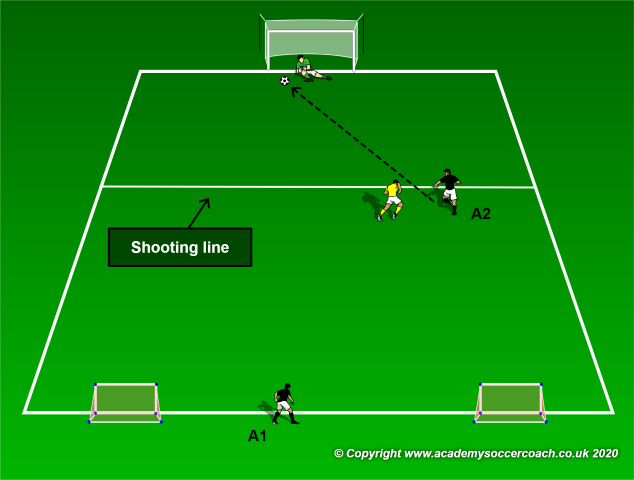
A shooting line can be introduced and which is marked 10 yards from the goal. This leaves an area measuring 10 yards by 10 yards where the 1v1 duel takes place. This is also more challenging for the attacker as he is forced to create the necessary space within a smaller area.
By Philip Cauchi
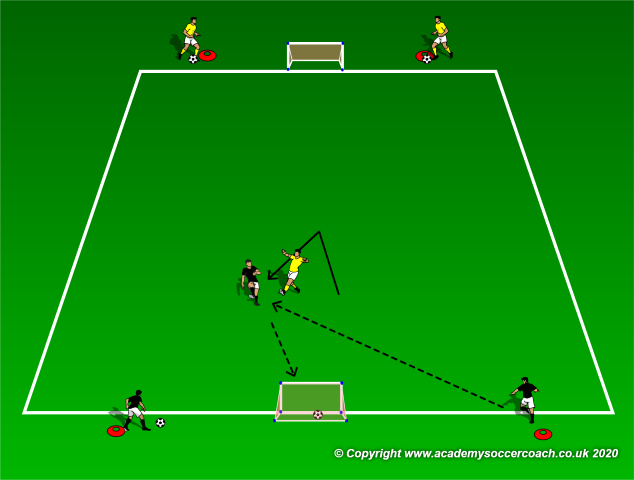
Lose Your Marker to Score Conditioning Game
By Philip Cauchi
Theme: Rapidity.
Development of the soccer domains:
Technical: Receive and control the ball while moving at speed. Finish with accuracy.
Tactical: Getting unmarked to receive the ball.
Mental: Quick thinking under opposition pressure of what moves to perform to lose the defender.
Physical: Perform rapid movements while maintaining the body in a state of equilibrium.
Organisation: An area measuring 12 yards by 12 yards. Outside players called feeders are positioned as shown in the first diagram.
Training load:
Sets: 2.
Repetitions: 4-6.
Duration each repetition: 6 to 8 seconds.
Recovery between repetitions: 60 to 80 seconds (work to rest ratio of 1:10).
Recovery between sets: 3 minutes (light technical activity may be performed during this period thus accelerating the recovery process).
N.B. This practice is beneficial both for attackers who need to create space and for the defenders who must track and mark tightly the attacker close to the goal.
Periodization: The exercise should be carried out immediately after the warm-up when the players are fresh and two days prior to a match (MD-2).
Targeted energy system: Anaerobic alactic (produce energy rapidly with minimal lactic acid build-up).
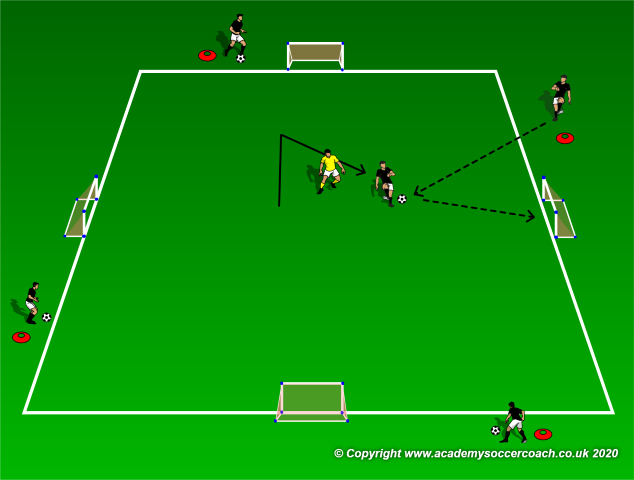
The attacker inside the marked area aims to lose the defender to receive the ball from any of the feeders positioned outside the area. The attacker can move to receive the ball from another feeder after finishing the first action. However, this must be performed within 8 seconds.
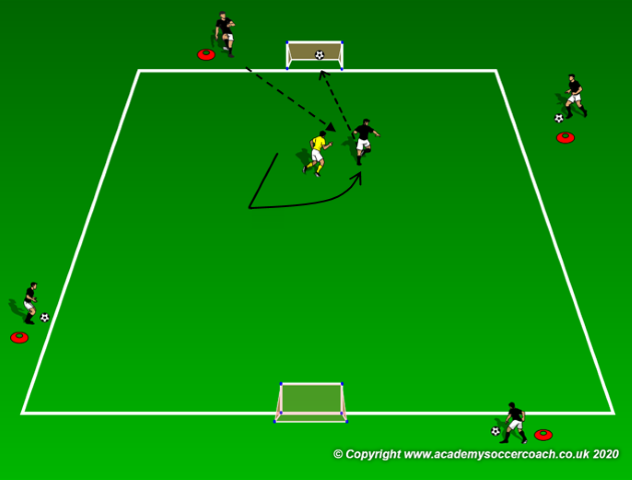
Progression 1 – The attacker can score in only two goals which are positioned opposite each other. This makes it more challenging for the attacker to get unmarked and score.

Progression 2 – Each player inside the area has two feeders on the same goal line. After the attacker concludes his action he must defend. Therefore, roles are changed immediately.
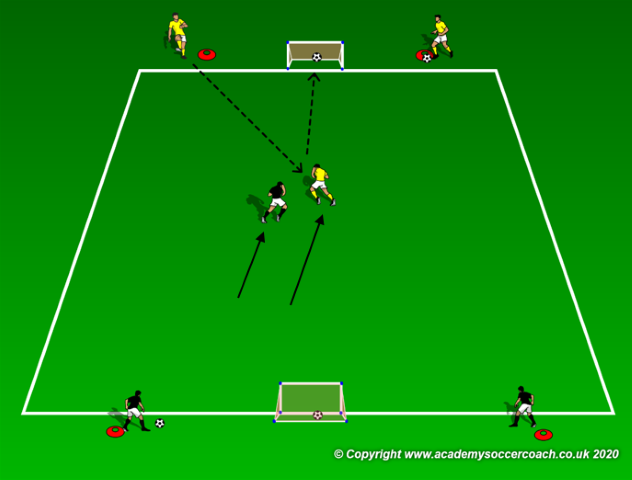
Transition occurs as now the defender becomes the attacker and immediately moves to receive a ball and score in the opposite mini goal.
By Philip Cauchi
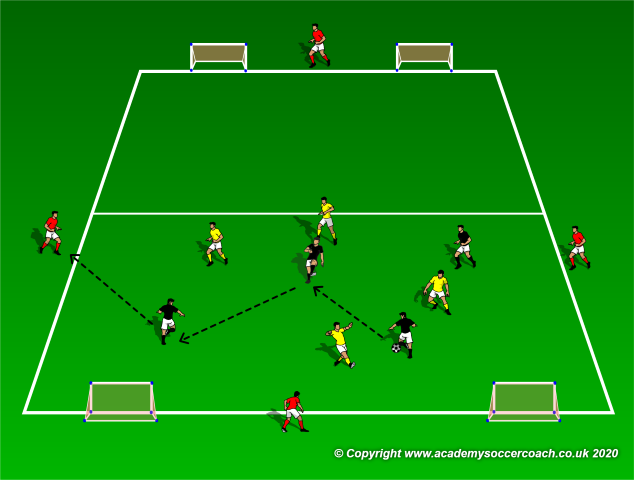
4v4+4 Aerobic High Intensity
By Philip Cauchi
Development of the soccer domains:
Technical: Maintain the quality of technical actions high for a prolonged period of time.
Tactical: In the offensive phase, circulate the ball rapidly with the intention of playing vertically. When the ball is played vertically, the players should quickly provide the target player with support. In the defensive phase, the defending team should recover quickly to prevent the opponents from scoring, win the ball and initiate a counter attack.
Mental: Players should be able to make quick and correct tactical decisions when defending, attacking and during moments of transition for a prolonged period of time.
Physical: Be able to apply the correct technical actions while delaying the onset of fatigue.
Social: Collaborate and communicate with teammates effectively throughout the game. The players should be able to quickly identify and react to their teammates’ movements (visual communication). For example, one player applies pressure on the ball-carrier while the nearby defender covers.
Organisation: Three teams of four players each. Area measuring 40 yards by 30 yards and which is divided into two equal horizontal zones of 20 yards in length each.
Training load:
Series: 6.
Duration each repetition: 3 minutes.
Recovery between repetitions: 1 minute 30 seconds (thus working with a ratio of 1:0.5).
N.B. The training load should be adjusted according to the physical level of the players. With high level players we can have longer durations, more series and also a lower recovery period.
Periodization: The exercise should be carried out after the warm-up as we want the quality of the soccer actions to be high. It should be carried out three days before match day (MD-3).
Targeted energy system: Anaerobic lactic.

The attacking team (blacks) aims to play the ball to the opposite target player (neutral red player).
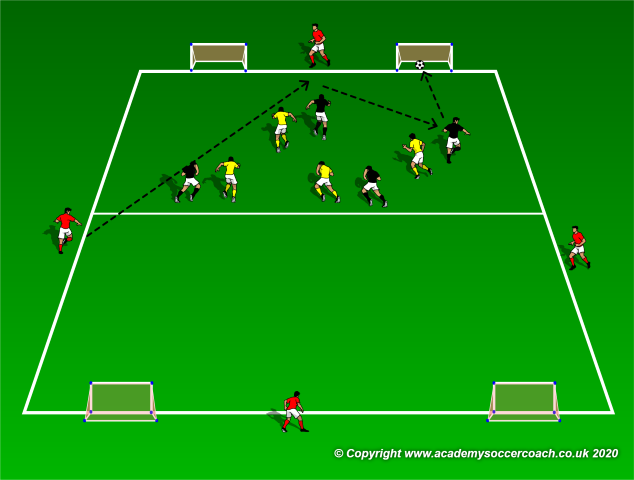
Once the ball is played to the target player, all the players from both set of teams move into the opposite half. The blacks aim to score, while the yellows try prevent the blacks from scoring, win the ball and counter on the opposite two mini goals.
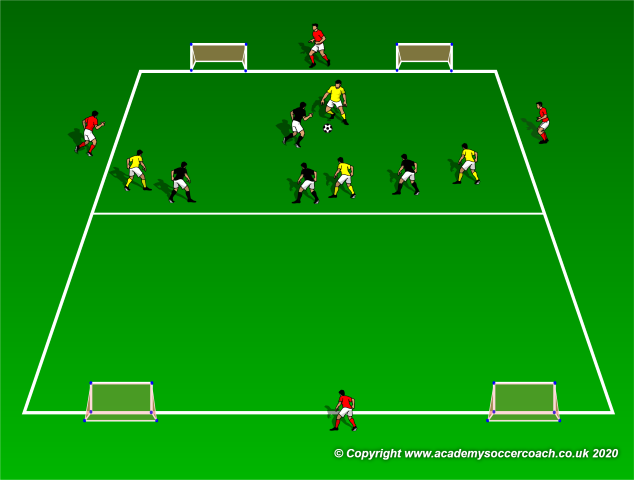
If the yellow team win the ball they aim to counter in the opposite half in the same way.
Variations:
1. The ball must only be played on the ground.
2. The ball may be played high.
3. Play takes place inside one half of the practice area. If the attacking team scores after combining with the target player from their own half, the goal counts twice. Any other means of scoring such as dribbling the ball into the opposite half counts as a single point.
Progression:
1. To further increase the physical and mental intensity, for a goal to count all members of the attacking team must be in the opposition’s half of the practice area at the moment of scoring. Furthermore, all the players of the defending team must be in their team’s defensive zone. Otherwise if a goal is scored the opponents are awarded double the points.
2. Another method of increasing the level of intensity is to play with the same conditions as in progression 1 but have the two halves of the pitch separated by five meters. This zone is known as the ‘no man’s land’. The dimensions of each half should remain the same.
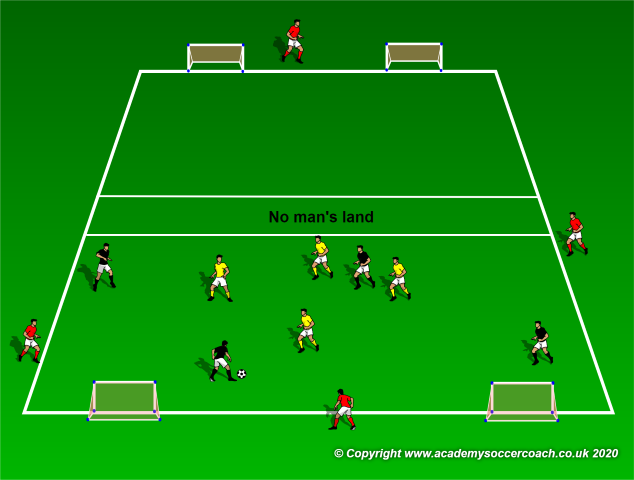
Progression 2. Increasing the running distance of the players with the introduction of the ‘no man’s land’.
N.B. After each series change the neutral flank and target players.
By Philip Cauchi

2v2+GK Explosive Sprints
By Philip Cauchi
Development of the soccer domains:
Technical: Quality of technical actions performed at speed and under opposition pressure. Turn with the ball, dribble at speed, pass with accuracy, oriented first touch and finish at goal with accuracy.
Tactical: In the offensive phase, provide quick support in attack while timing forward runs. Follow up shots for rebounds while attacking both the first and second post areas. In the defensive phase, recover quickly to prevent the attackers from concluding at goal.
Mental: In the offensive phase, keep focused while performing attacking actions under pressure from opponents. In the defensive phase, the players must track back and defend with a positive attitude of preventing the opponents from scoring.
Physical: Applied soccer actions performed at speed to either attack or defend.
Social: Collaborate and communicate (verbal and non-verbal) with teammate to either score or defend.
Training load:
Sets: 2.
Repetitions: 6.
Duration each repetition: 3 to 4 seconds.
Recovery between repetitions: 30 to 40 seconds (thus working at a ratio of 1:10).
Recovery between sets: 3 minutes (light technical activity may be performed during this period thus accelerating the recovery process).
N.B. The training load should be adjusted according to the physical level and maturity of the players. Players should be positioned within positions and situations they typically experience during a match.
Periodization: The exercise should be carried out immediately after the warm-up when the players are fresh and two days before match day (MD-2).
Targeted energy system: Anaerobic alactic.
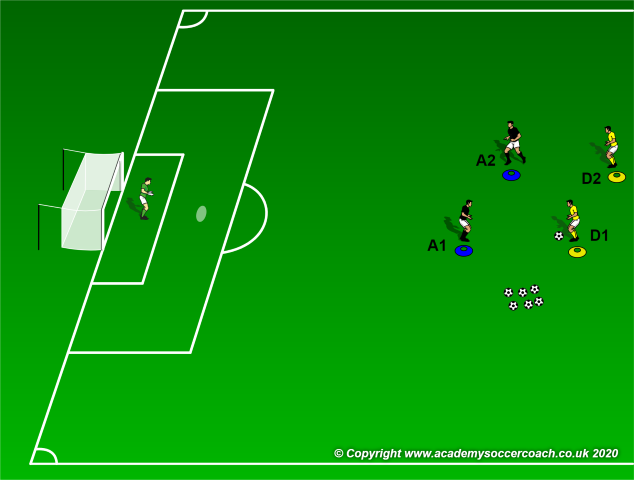
Attacker A1 starts facing the defender D1 two yards apart. Defender D1 starts with a ball at his feet. Defender D2 starts slightly behind and three yards away from defender D1. Attacker A2 is positioned 2 yards in front of defender D2.
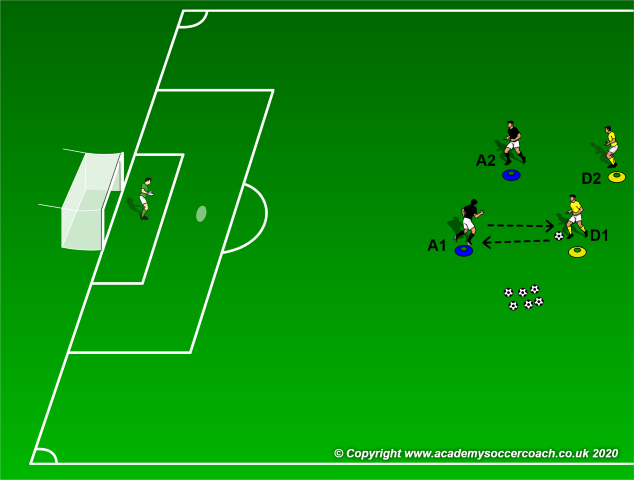
Attacker A1 and defender D1 pass the ball back and forth to each other.
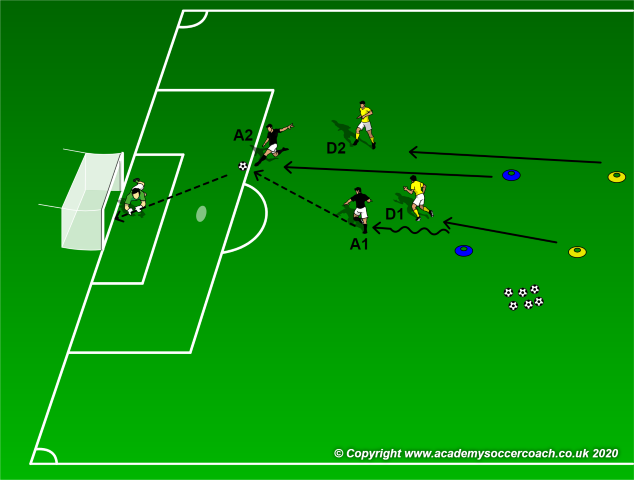
Attacker A1 turns at his discretion to dribble towards the goal. At this moment all the other players become active. Attacker A1 must pass the ball to attacker A2 to finish on goal. The attackers have a time limit to score from the moment attacker A1 turns to attack the goal. The offside rule is in effect.
Progression 1:
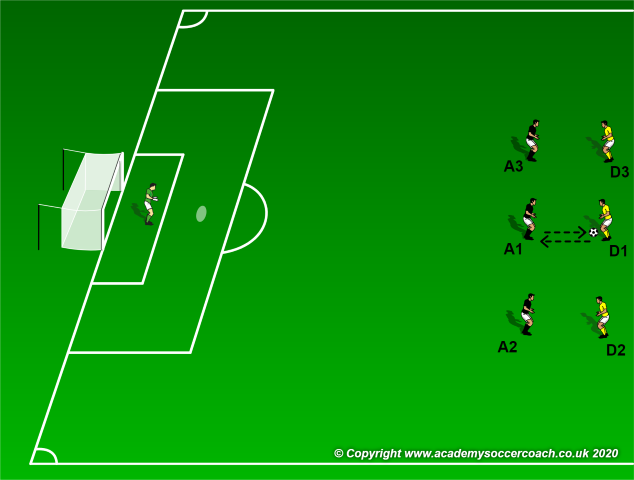
Now we play 3v3 with the offside rule is in effect.
Progression 2:
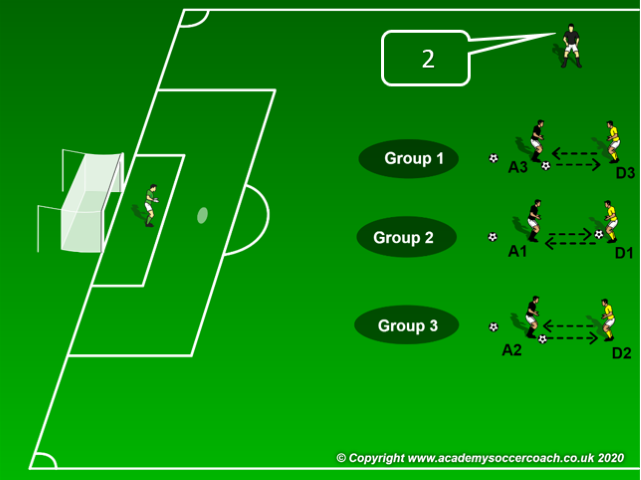
The attackers and defenders in all three groups pass the ball back and forth to each other. The coach calls out a number that represents a specific group. The attacker in this group must quickly turn and dribble the ball positioned one yard behind him. The other two attackers and the three defenders must quickly react to this visual stimulus. The attackers must score after all of them have touched the ball. If this proves to be too hard or slows down the action, remove the constraint that all the attackers should touch the ball before attempting a shot on goal. Instead we can challenge the attackers by having them finish at goal in five seconds or less from the moment the coach calls the player to initiate the attack.
By Philip Cauchi
